Ahmedabad’s Tastemakers
November 27, 2019
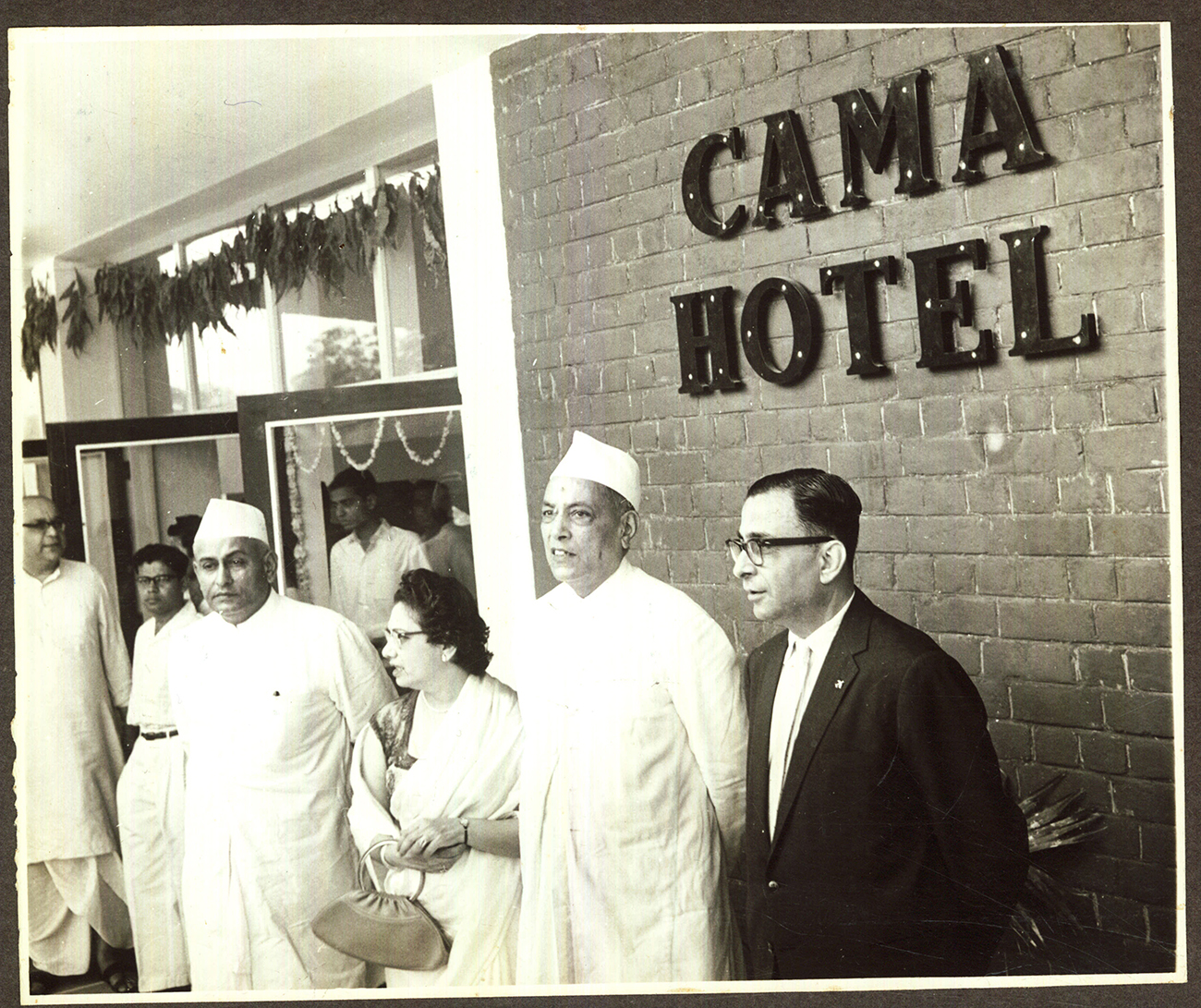
The Gujarati thali is a quintessential experience for most visitors to Ahmedabad. The thali presents a balance of colours, tastes and textures, comprising of farsans, three vegetable dishes, a dal or a kadhi ,rotis, rice, sweets and accompaniments. This thali is said to have been first curated by Chimanlal Joshi, the founder of Chandravilas.
Located near the markets around ManekChowk, Chandravilas launched the thali in the early-1900s at one rupee. Appointed with French oak furniture and British-made fans, this became a favorite haunt of the merchants, the shoppers, and also the families from rural areas and small towns who came in to shop at Ahmedabad. They washed their hands at the copper wash basin before settling down to eat at the restaurant. It was also known for its variety of teas. Till today, patrons swear by its dal and its jalebis, and its fafda – jalebi breakfast draws tourists visiting nearby monuments. The present owners take pride in talking about the role of this restaurant in the freedom struggle and later the agitation for Gujarat’s statehood, the gathering of independence activists for a `bhajiya club’. When a film star like Raj Kapoor visited the cinemas on Gandhi Road, the food would be ordered at Chandravilas.
In those days, Gandhi Road and historic ManekChowk bustled with eateries. The Kandois (halwais) were in this area – KandoiBhogilalMulchand claims to have been around from the 1850s and Jayhind sweets from the 1940s. Das Khaman was started in 1922 and is still thriving here as at their new outlets in the west of the city. When I visited Khas Bazaar and its BhatiyarGalli the owner of the one of the outlets showed me British period documents showing his eatery existed from the 1800s and is even today a go-to destination for a meat feast. Gandhi Cold Drinks was started in 1913 and in the Badhra area is still an iconic stop for faluda, ice-creams and juices.
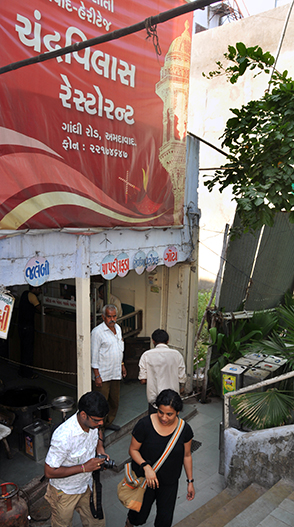 Chandravilas, the pioneer of Gujarati thalis
Chandravilas, the pioneer of Gujarati thalisThe Ice-cream Industry
One of the places my late father always told me about is the Vadilal Soda Fountain where he would go with his parents and brothers for an ice-cream. Vadilal Gandhi used to make hand-churned ice cream and they even offered home delivery.In 1926, they imported ice-cream making machines, paying custom duty of 300-350%. Vadilal, which had expanded to four ice-cream shops before independence, became popular for its cassata ice cream, which it introduced in the 1950s. It remained a city brand till 1972-73 before going into mass manufacturing.
Pioneering Hoteliers
The growth of the textile industry led to a demand for hotels in the city. The pioneer of the textile industry in Ahmedabad was the late RanchhodlalChhotalal, who received support of ShethShamalBechar from Vadodara, the Maharaja of Rajpipla, GaurishankarOza (Diwan of Bhavnagar), MaganbhaiKaramchand, PremabhaiHirabhai, KesarisingHathising, and a British gentleman named Mr White. With the capital subscribed by five shareholders, Ranchhodlal placed an order for the machinery with DadabhoyNaoroji who was in London managing an Indian owned firm at the time. Thus, Ahmedabad Spinning & Weaving Mills, better known as Shahpur Mills, was inaugurated on 30th May 1861, marking the first step towards the industrialisation of Gujarat. Its engine was named Adventure by MrsEdington who broke a wine bottle to mark the hugely attended inauguration. From four textile mills in the 1880s, the number grew to 27 in 1900, 33 in 1906 and 52 in 1910. The mills were proving that India can also produce fine cloths, introducing mercerizing processes and improving the yarn quality. Dhotis became finer, sarees became colourful, chintz came with artistic designs for British, Portuguese and other markets, voilsand mull of high quality was in production. Enterprising mill owners went abroad to study new developments and technologies to upgrade their mills to make the industry more organized and efficient. A few industrialists like Sheth Kasturbhai Lalbhai and Sheth Ambalal Sarabhai worked to produce fine and durable cloth at competitive rates.
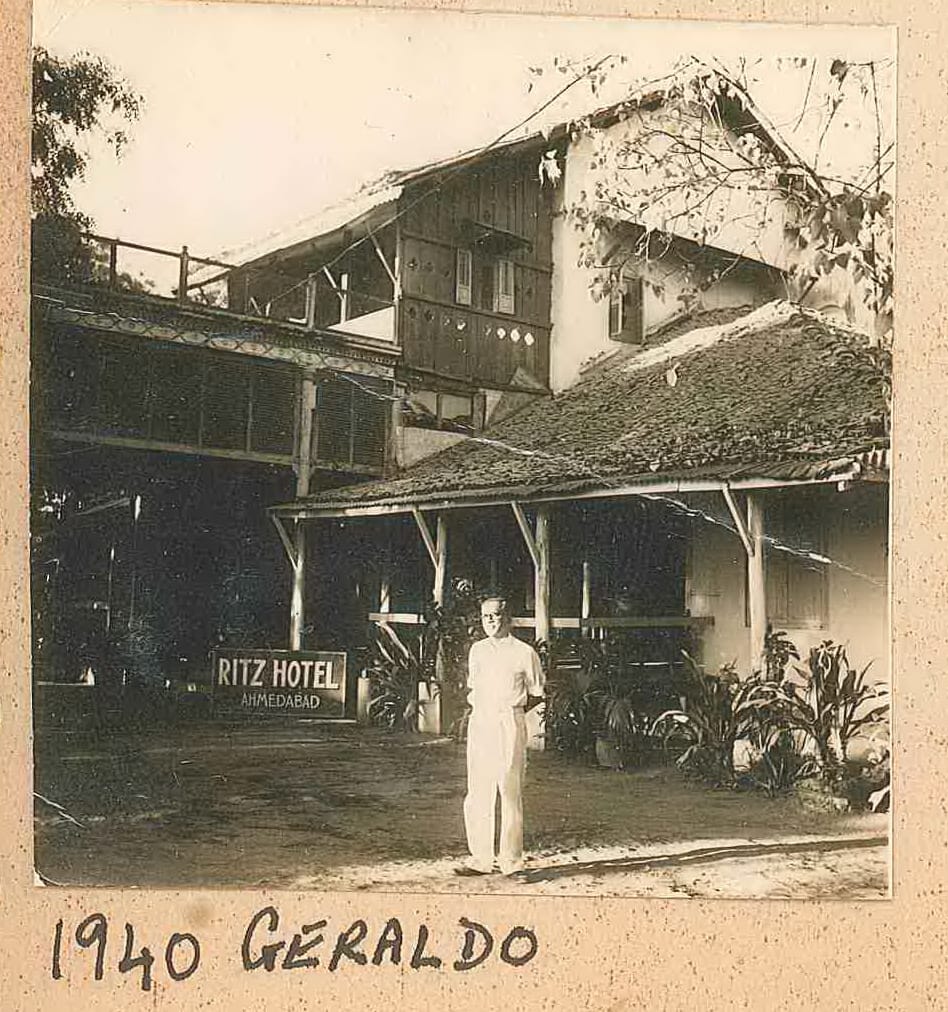 Ritz Hotel was opened in 1939
Ritz Hotel was opened in 1939This created a demand for hotels in the city. Geraldo Pereira opened the Ritz Hotel in around 1939 and it was a thriving hotel by 1940. I have childhood memories of the roast meats and fried fish of this colonial period hotel of Ahmedabad. I attended the wedding banquet of my Catholic school teachers at this hotel, an Ahmedabad landmark.
The grand dame of Ahmedabad during my schooldays was Cama Hotel. Rustom Cama was inspired by his friends in the textile industry to start a hotel. Mayor Chunnibhai and Sheth Kasturbhai Lalbhai are said to have been the great supporters of this enterprise. A hotel was much needed in the city and Gujarat got statehood too in 1960.
There were more than 66 textile mills employing over 1,41,000 workers in all. In 1961, the centenary of the Ahmedabad textile mill industry was celebrated with an exhibition inaugurated by Prime Minister Nehru. In those days, about 25% of India’s textile production was accounted for by the textile mills of Ahmedabad. Many senior residents of Ahmedabad recall how the bonus is given to workers by these mills before Diwali would make the markets of the city glitter during the festive week.
Cama Hotel was designed by the famous architect Charles Correa credited for the creation of modern architecture in post-Independent India. Aboodana was Cama’s restaurant where I used to go with my parents when we had guests at home. I remember a meal of prawn cocktails, baked dishes and baked Alaska in the 1970s when the Purple Flower band was playing western music in this restaurant. They also had ghazaland Indian music nights.
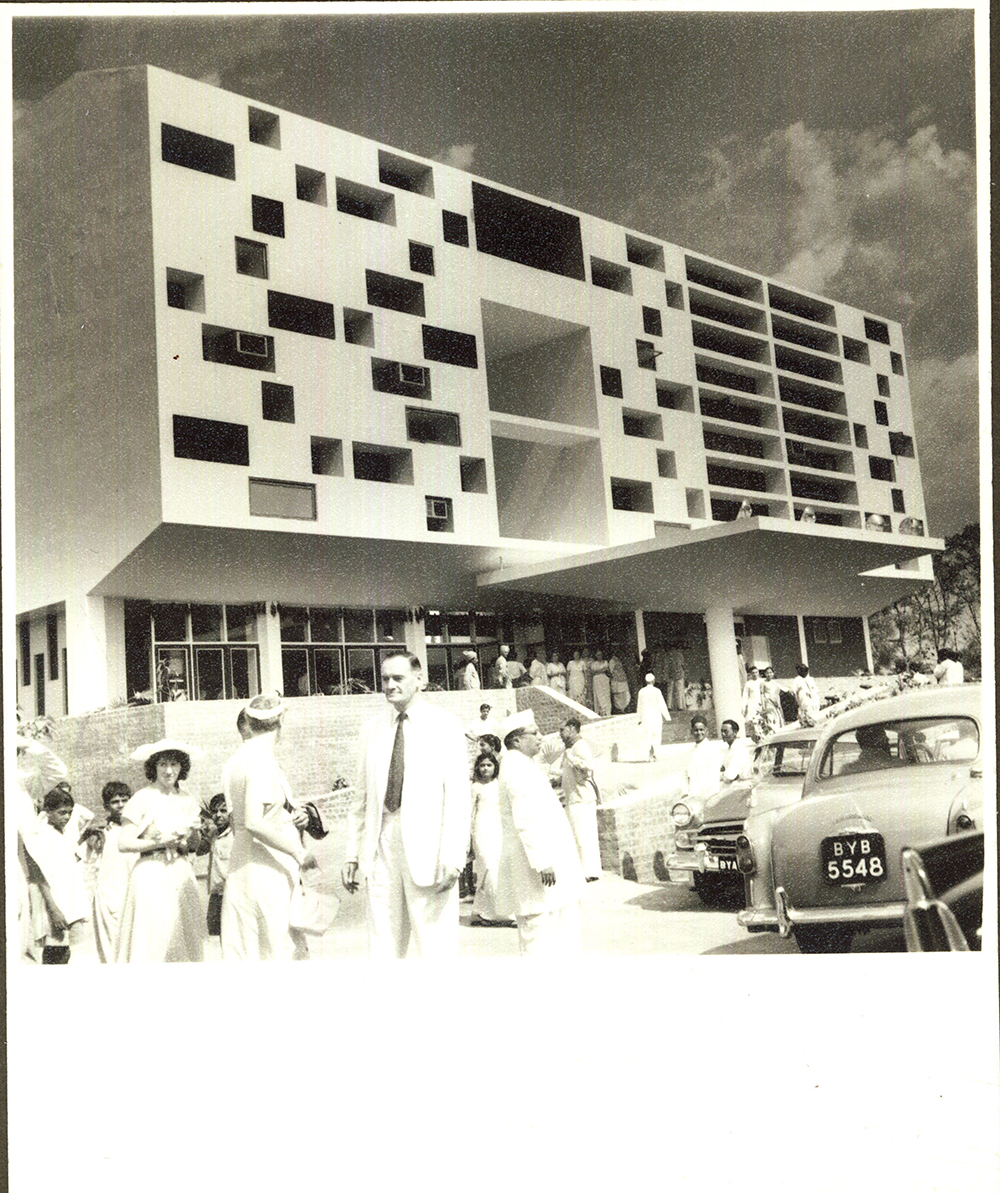
The North Indian Food Boom
 Cama Hotel opened in 1960
Cama Hotel opened in 1960The growth of industry in Ahmedabad attracted a growing mix of people to the city. Parsees had settled in the city, some became mill owners, some entered professions like insurance and banking, others found good jobs. The Bene Israel Jews also came from Mumbai and other parts of Maharashtra to work in the city. A Tamil area developed in the Maninagar – Khokra belt near the industrial areas. Migration from Kerala for jobs in mills was common. Old Madras Brahmin near Badhra Fort, Jaya Udupi near Laldarwaja, and South Indian places elsewhere like Ellisbridge, Paldi and Ashram Road began to mushroom.
Following partition, a number of Sindhis and a few others like Punjabis settled in Ahmedabad. I am often told that the wide-spread availability of fruits and nuts in Ahmedabad is because of this migration. Sindhis started their trade around Relief Road and Gandhi Road – Revdi Bazaar, Sindhi Market, the cloth markets, the wholesale hubs for food grains, sugar, fruits, vegetables and groceries and the Radio Market. MotumalTanumal became known for its sharbat parlour. Azad Sweets & Restaurant was started by Jumromal V Rochwani in 1958.Anand Sweets was another known Sindhi eatery in Kalupur. In the camp areas of Wadaj, Kubernagar and Sardarnagartoo a number of Sindhi owned eateries were opened, like Shikarpuri has been there from 1952. Dal Pakwan and North Indian style dishes were popularized by these eateries. Satish Chandra Chona’sHavmor started with his handmade ice-creams and later branched into restaurants – the Havmor story is detailed later in this article.
Neelam was a Sikh owned restaurant that taught Ahmedabad’s people to love Punjabi food. People still swear by the tandoori chicken and mutton dishes of the owner’s descendants at Neelam’sLutf. The taste of their malai kofta still lingers in the minds of many of Neelam’s spatrons. Punjabi dhabas and restaurants with names like Sher-e-Punjab and Mehfil started coming up.
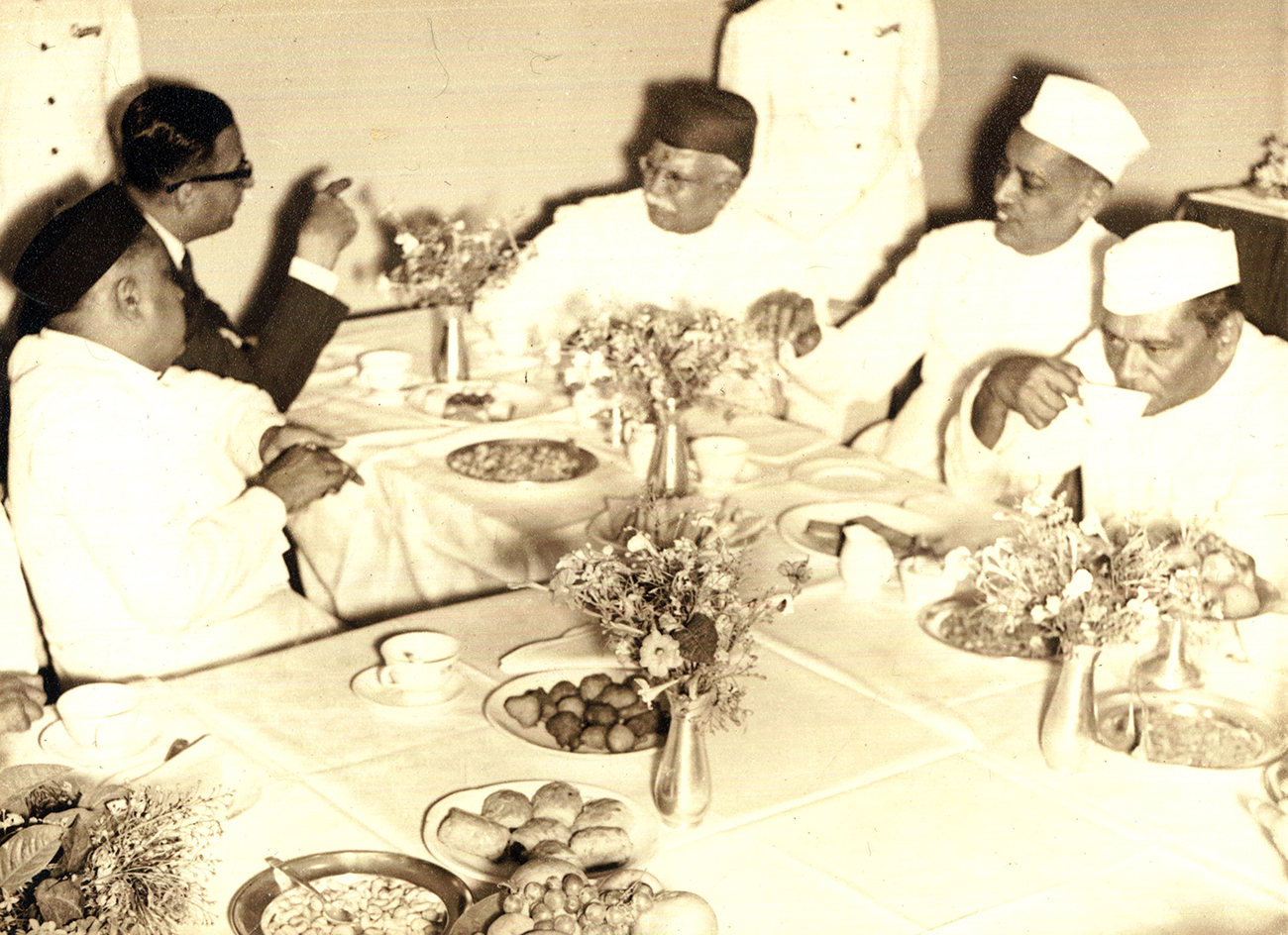
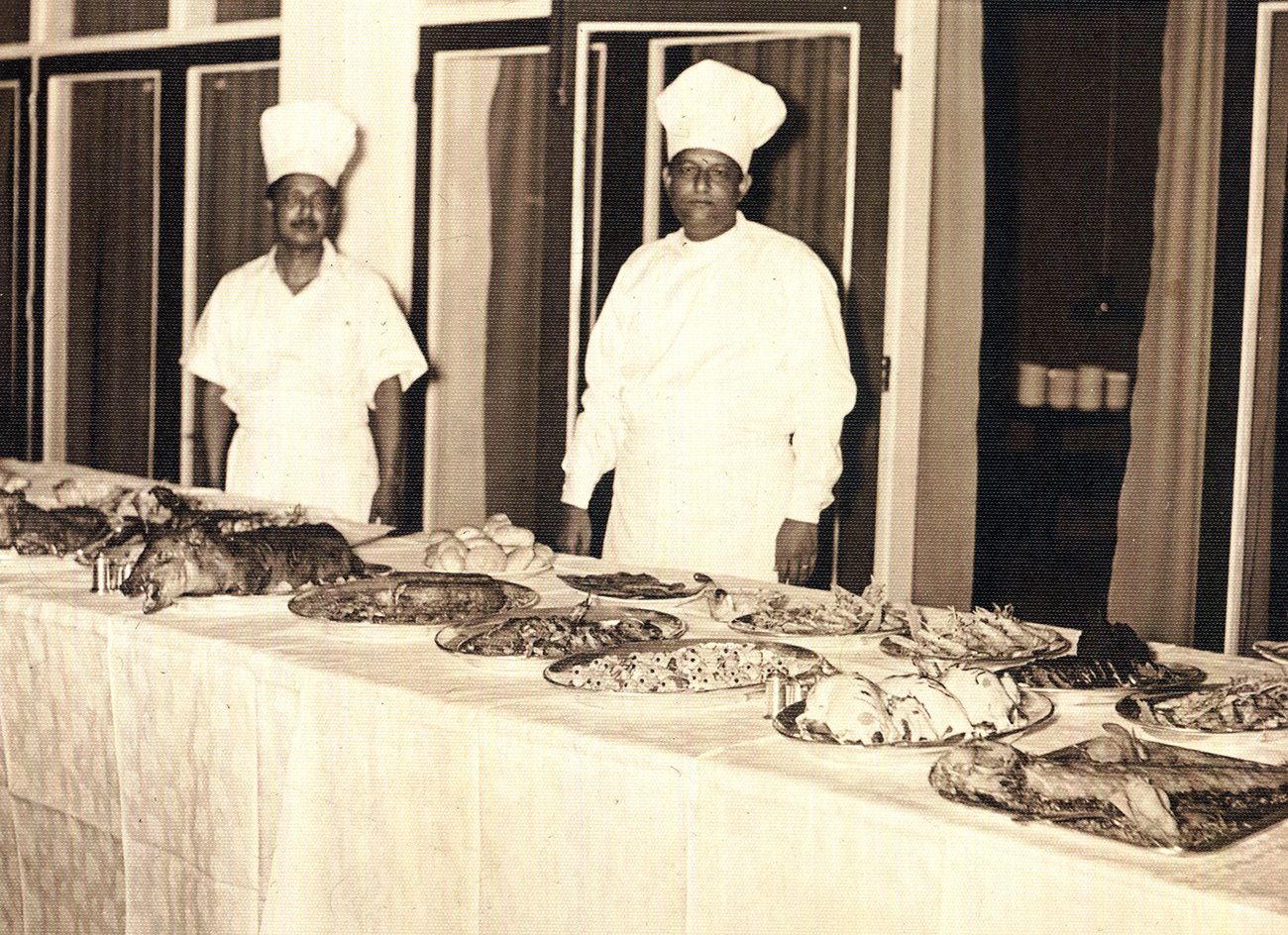 Cama Hotel introduced many new cuisine to Ahmedabad
Cama Hotel introduced many new cuisine to AhmedabadThe Quest for Continental Food
During the 1960s and 70s, the fashionable restaurants of India were those that served European food, mostly those from the cold Continental that were loaded with butter or cheese. Those were the glory days of Park Street Dining in Kolkata, the star-studded restaurants and hotels of Mumbai where Bollywood celebrities, socialites and industrialists gathered. Kwality was one of the brands known for its Continental Food in Ahmedabad. I have fond memories of family dinners with the Chicken Kiev, Chicken Cecilia, Mixed Grill, Chicken Mayo, Egg Salad and Fried Fish. Nobody watched their calories in those days – The Chicken a la Bomb or Chicken a la Kiev would burst with butter as soon as you pierced them with the fork and the creamy Kwality Special Pudding was a fast moving order. Albert D’Souza with his flamboyant moustache became a familiar face for the patrons as we went around taking orders personally.
Entertainment in those days was about cinema and eating out. Bankura became a must visit combination with the Roopalee Cinema for baked dishes. They also claim to have brought pizza to Ahmedabad for the first time.
Paramount became a handy restaurant near Advance Cinema. While Mughlai food was the forte of MotiMahal Hotel, ZK and others in the city, Paramount drew the cosmopolitan crowd coming to this theatre for English movies by introducing western food. The owners once told me that for many visitors to Paramount this was the first time they were going to a `knife-and-fork’ restaurant. They were learning how to eat in the western style. The success of the early restaurants like Paramount, Volga and Food Inn inspired ChiliyaMomin families from Himmatnagar, Vadnagar, Mehsana, Sidhapur to enter the restaurant business, and today they have much of the market share of Ahmedabad.
The area around Khanpur was the fashionable neighborhood of the time with Parekh’s splendid Department Store, hotels like Ritz and Cama, car showrooms and cinema theatres. Mary Lobo’s La Bella was known for its stews and other meat dishes at value for money prices.
Going West
By the late-1970s the scene was fast moving to the areas west of the city. Ashram Road was a central business district. Restaurants came up on this road. RajendraThakker of Gopi Dining Hall once told me that there were more than one dozen thali restaurants on Ashram Road. Toran is one of these that is still iconic. One of the many stories of enterprise in Ahmedabad is that of Damodar Thakkar who came from a modest background, having worked as a dishwasher in eateries from north Gujarat to Mumbai. He was a police constable and also a good car mechanic. He saw a gap in the Ellisbridge area for tea, snacks and quick meals. Thus, he started a tea stall, JalaramParotha House and later Gopi Dining Hall. Gopi became the place for many NGOs and corporate offices for a thali or a takeaway.
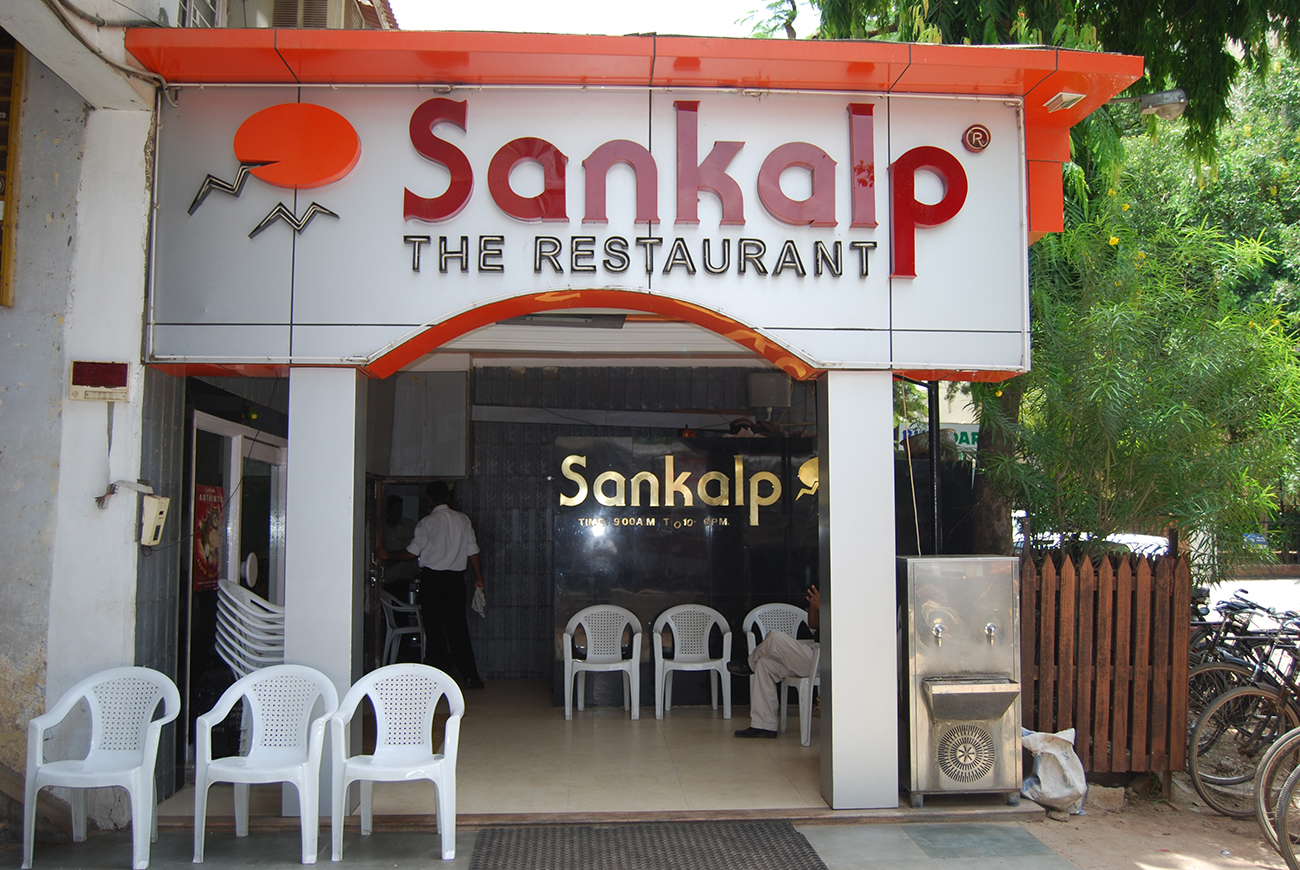 The first Sankalp, started in 1980s
The first Sankalp, started in 1980sAshram Road also had many upmarket places to eat and some hotels too in the 1970s and ‘80s.This is where Sankalp too first opened in Ahmedabad.
A wave of new entrepreneurship
By the late-1980s and 90s there was a growing interest in the restaurant business. Newer cuisines were being introduced in Ahmedabad. Patang, the revolving restaurant, became a landmark of Ashram Road, and Garden Café downstairs became the place for delicious food and a great ambience. This led the growth of more places for dumpukt food and pastries.
Mr Pasricha was an entrepreneur that many remember fondly – as his wife says, ‘usne Ahmedabad ke log ko khana sikhaya’ (he taught the people of Ahmedabad to eat well). A hospitality professional qualified from Mumbai, he started Sheeba, which became an iconic landmark on CG Road, where he introduced rich curries from Patiala, varied Punjabi and Mughlai fare, and multi-cuisine too. Sheeba was the place for chicken and river fish, and many vegetarians had paneer for the first time in this restaurant.
More importantly, he was bold in introducing new cuisines. He started a Chinese restaurant upstairs, introduced multi-cuisine including western food on the menu, opened an ice-cream sundae parlour in the forecourt, and started a Frankie station.
Drive-in movies were trending and the road from the residential areas to Drive-in Cinema became hubs for eateries. Hunger Hop was an Indian Chinese place by the Duas, Naigara was the café for salads and sandwiches, Hasty Tasty was a name associated with tasty food. 10-The Restaurant and Gallops were CG Road icons. Paul D’Souza was the man of the moment, known for his food. Havmor started smart restaurant at Stadium. China Town brought Chinese dishes to Ahmedabad.Colours of Spice launched Thai food in Ahmedabad.
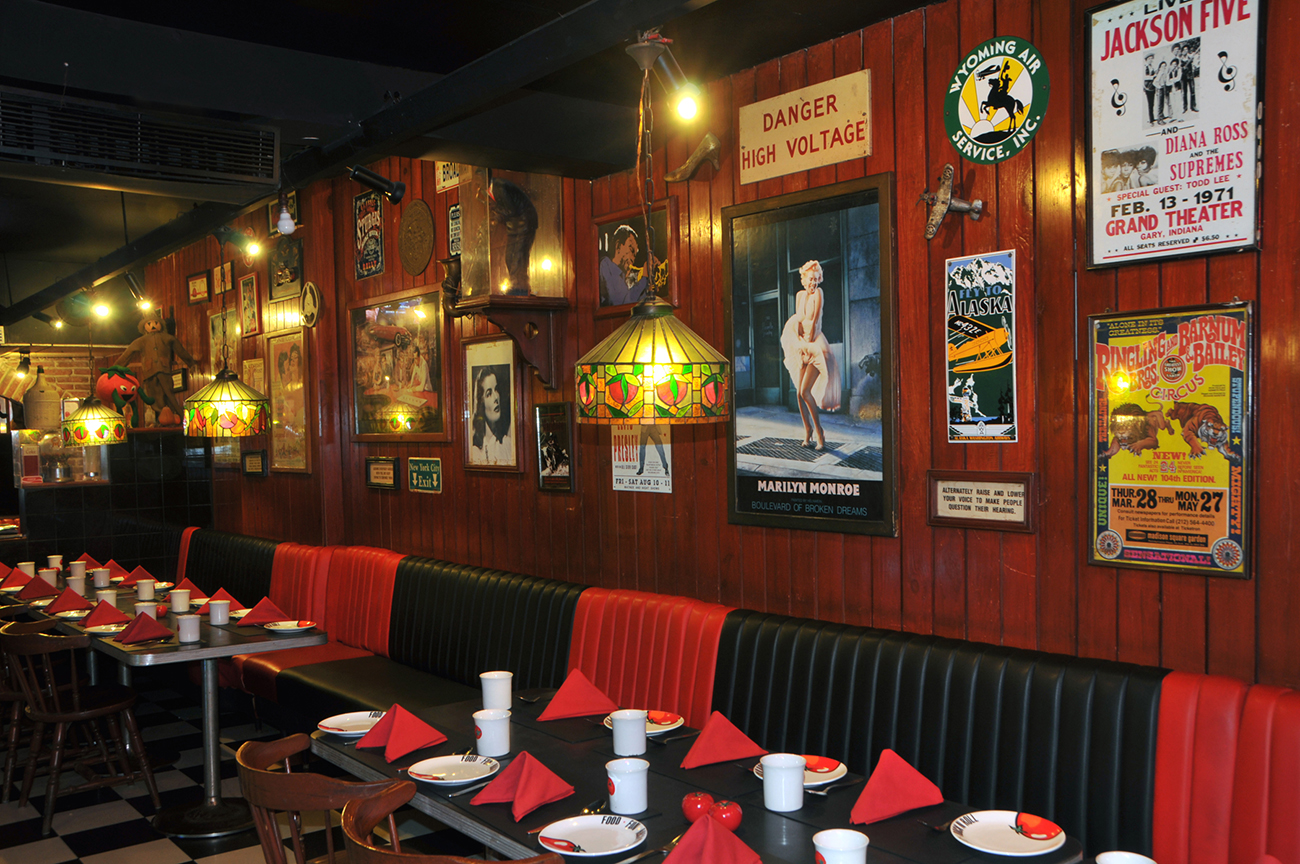 Tomato’s Restaurant
Tomato’s RestaurantWith the growing demand, some of the street food entrepreneurs too started entering formal businesses – Honest and Asharfi are examples that come to mind.
Not all sustained in the business, some closed down because of financial losses, others moved to their family businesses, some migrated abroad.
Rushad Ginwala’sMirch Masala and Tomatos, Lester D’souza’s Upper Crust, and a few other brands launched in the 1990s, however, continue their growth trajectory event today.
The New Millennium
By the early-2000s, people from other states and national brands began to move into the city. One of the success stories is that of Gwalia – the Sharma family that is in the sweets business at places in Bihar and Assam, launched in Ahmedabad bringing in specialties of the eastern states. They made the most of the mall and multiplex boom by opening outlets at Fun Republic, City Gold and other entertainment centres.


